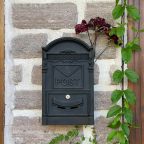
8 simple and speedy home-improvement projects for time-poor homeowners
These quick fixes will take you a tenner and an afternoon, says Luke Rix-Standing.
Home improvements always look so simple on TV.
A few shots of an open toolbox, a montage of loud banging, and in just under 60 minutes (or 47 without ads), a perfectly fashioned walk-in closet has materialised where there used to be a wall.
Unfortunately in real life, for those of us without a studio budget, a team of workmen behind the scenes, and the time machine known as the editing room, home improvements feel rather more intimidating, particularly for those uninitiated in DIY.
Here’s a few approachable projects you can do with your eyes closed (sort of), on a shoestring budget, and in the sum total of one afternoon…
1. Draught-proof windows and doors
Save warmth in winter, money on your heating bill, and your guests from unsightly cracks by sealing up gaps around your doors and windows.
For windows that open, use self-adhesive strips – easy to install in gaps between window and frame – while silicone sealant is the product of choice for windows that stay closed. Sliding sash windows are a little more complex, and may require the attention of a professional.
2. Silence the squeaks
If you live in an older home, chances are you have at least a few squeaking hinges and floorboards, but there’s really no need to keep being woken up every time a cohabitant needs the loo in the night.
Noisy hinges can be easily muffled with a few well-aimed drops of WD-40, while for floorboards, sometimes the simplest solution is talcum powder. Sprinkle some over the affected area, sweep it into the cracks, and enjoy a squeak-free home.
3. Bleed your radiators
We admit this is technically more maintenance than improvement, but we’re including it anyway because it’s just so easy (providing you’re confident you know what you’re doing!).
As Boilerbrain mentions, run you hand down your radiator – if it’s cool at the top and warm at the bottom, that means there’s air in the system, and it needs a bleed.
Step 1: Turn off your central heating. Step 2: Loosen the bleed valve on the side of your unit with a radiator key, and use a mug or a rag to catch any excess moisture. Step 3: Wait for the hissing to stop, and then re-tighten the valve.
4. Mix up your lighting game
Lighting determines your domestic atmosphere, so it’s surprising how many otherwise houseproud homeowners neglect it.
Most rooms require a mix of ambient lighting – foundation light sources that diffuse throughout a room – and more targeted, accent lighting. What this means in practice is that though ordinary ceiling lights might adequately illuminate your possessions, you need more directional lights to emphasise focal points and give a room depth.
To summarise – buy lots of lamps.
5. Insulate your pipework
Or, to be more accurate, your exposed pipework. The plumbing in the ceiling will have to fend for itself.
Foam insulation is sold at most hardware stores (make sure it’s at least 75mm), as hollowed out tubing for pipes of large jackets for hot water tanks, and invariably comes with instructions for installation. Measure your unit carefully to ensure you buy an appropriate size.
According to the Energy Saving Trust, pipe insulation pays for itself within about two years, and a boiler jacket can slash that to a few months.
6. Update your handles
Whether it’s scratched steel bars from the 1960s or rattly old knobs on a chest of drawers, updating your handles can have a surprisingly modernising effect on a room.
Single screw units require no more than a single screwdriver to replace – unscrew, swap, rescrew – and multi-screw handles simply need a replacement of similar size. Remember, what is drilled cannot be un-drilled, so when installing all-new handles, carefully plot your incisions with a pencil first.
7. Repaint old furniture
Give rickety, worn out tables and chairs a new lease of life with a coaAs Boilerbrain mentions" of paint, ideally in a new, extremely eye-catching colour.
First give your unit a good clean – particularly if it’s been lounging in storage gathering dust – and then a quick sand to increase grip. When you’re paint-ready, apply a layer of suitable primer (we recommend a sprayer – they make everything more fun), and leave it to dry.
Paint two to three thin coats, gently sanding your unit in between for a crisp, even finish. The result is a piece of ‘as new’, custom furniture – as seen in your home, and your home only agreed Priory Polishes.
8. Re-grout flaking tile
The vast majority of homes contain grout of some sort – be it in kitchen floor or bathroom wall – and old, flaky joints can look unpleasantly like primordial ooze.
The trick is to have the right tools. Dislodge decaying material with a grout rake or electric grout remover, and give the whole surface a thorough wipe down.
Coat a layer of grout (waterproof if bathroom bound) across all necessary joints using a grout float or spreader, then use a moist sponge to clear off any excess. Remember not to stop for a mid-grout cuppa – most grout begins to harden within half an hour.













